Bali may be known for its postcard-perfect beaches and serene temples, but its true essence is found in the meals that have been passed down for generations. Traditional Balinese cuisine isn’t just about eating—it’s about honoring rituals, family gatherings, and the island’s deep spiritual connection to food.
Every dish tells a story of community and heritage. Whether it’s the smoky aroma of Babi Guling prepared for a temple ceremony, the slow-cooked richness of Bebek Betutu at family celebrations, or the colorful array of Jaje Bali sweets offered to the gods, Balinese cuisine reflects a culture where food is both nourishment and devotion.
In this guide, you’ll explore the dishes that define Balinese tradition. From ceremonial feasts to everyday staples, you’ll discover the flavors and cultural meanings behind the island’s most iconic meals.
Own your COCO property in paradise with benefits for life
- +200 properties in construction
- +250 properties in full operation
- Pay 20% of your property straight from rental profit
The Flavor of Bali: More Than Just Food
To understand Balinese cuisine, you need to appreciate its roots. It is a reflection of the island’s complex cultural tapestry: a blend of indigenous traditions, Hindu influences, and centuries of trade with India, China, and the Middle East.
Spices such as turmeric, coriander, lemongrass, galangal, and candlenut form the backbone of many recipes, often blended into base gede, the spice paste essential to Balinese cooking. Pork, rare in much of Indonesia, plays a prominent role here, particularly in ceremonial dishes.
Equally important are the cooking techniques that bring these flavors to life. Whole animals are slow-roasted over open flames for ceremonies, meats are wrapped in banana leaves and steamed or baked in earthen pits, while satays and fish are grilled over coconut husks for a smoky depth. Stewing and stir-frying in coconut oil are also common, allowing spices to fully infuse the dish. These traditional methods highlight the island’s resourcefulness and close relationship with fire, earth, and nature.
Food also carries a sacred meaning. Daily offerings, festive meals, and temple feasts highlight the intimate link between spirituality and cuisine, making every bite both a sensory and cultural experience.
Watch Out for “Bali Belly” (and How to Avoid It)
But before you jump headfirst into Bali’s irresistible food scene, let’s talk about Bali Belly. This common travel woe, often a mild form of food poisoning or traveler’s diarrhea, is typically caused by bacteria or viruses found in contaminated food or water, usually due to inconsistent sanitation or hygiene practices. While it’s not unique to Bali, it can be an unwelcome detour on your culinary adventure. In fact, according to a 2024 travel health report, an estimated 20 to 50 percent of travelers to Bali experience some form of digestive upset during their stay.
But here’s the good news: Bali Belly is largely preventable, and it shouldn’t keep you from enjoying Bali’s street food paradise. With just a few smart precautions, you can eat boldly and safely.
Here’s how to minimize your risk:
- Eat where locals eat. If a stall is crowded, it usually means the food is fresh and the turnover is fast—two great signs of safety.
- Stick to hot, freshly cooked dishes. Heat kills most common bacteria. Grilled satays, sizzling noodles, and bubbling broths are usually safer than pre-made or lukewarm options.
- Avoid raw salads or uncooked garnishes, especially from small vendors, unless you’re confident in their hygiene practices.
- Be careful with ice. Unless you’re sure it’s made with purified water (cylinder-shaped ice is usually government-distributed and safe), skip it in your drinks.
- Practice good hand hygiene. Carry hand sanitizer or wash your hands before and after meals. Many cases of Bali Belly come from touching your face or food with dirty hands.
- Pack a travel kit. Include activated charcoal tablets, probiotics, or oral rehydration salts (ORS). These can help manage symptoms if you do get hit.
- Drink bottled or filtered water only. Even when brushing your teeth, avoid tap water.
While Bali’s food stalls and warungs have become more regulated and hygienic over the years especially in tourist hotspots like Seminyak, Ubud, and Canggu, precaution is still key. Treat food with respect, not fear, and you’ll likely avoid any digestive drama. After all, eating traditional Balinese food is one of the best ways to experience the island.
Must-Try Traditional Dishes
Now that you know what to look out for and have a good idea of the flavors Balinese traditional food brings to the table, it’s time to explore several of their must-try dishes, categorized by dietary preference.
Meat-Based Must-Tries
Babi Guling
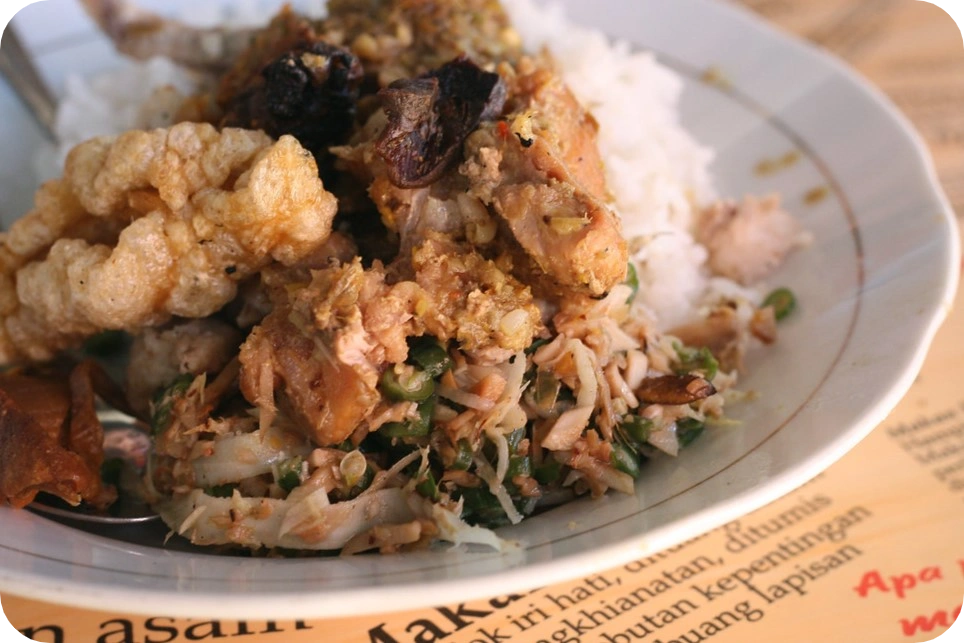
Possibly the island’s most iconic dish, babi guling is a whole pig, slow-roasted until crispy and aromatic, usually served with rice, lawar (spiced veggies), and a spoonful of sambal. Seasoned with turmeric, coriander, lemongrass, and other local spices, it’s a dish deeply rooted in Balinese tradition and bursting with bold flavors.
And while you can find babi guling in roadside stalls and local warungs, those with a bit of extra budget should head to Ibu Oka in Ubud. Often hailed as the best place on the island to try this dish, Ibu Oka gained international fame when travel documentarian and Chef Anthony Bourdain declared it the best pork he had ever eaten. Their Babi Guling Set offers everything from crackling skin to tender meat, all cooked over coconut husks for a deep, smoky flavor. The no-frills setting adds to the charm—just be ready for wooden benches and a crowd. Still, the depth of flavor and cultural experience make it a must-try for meat lovers visiting Bali.
Bebek & Ayam Betutu
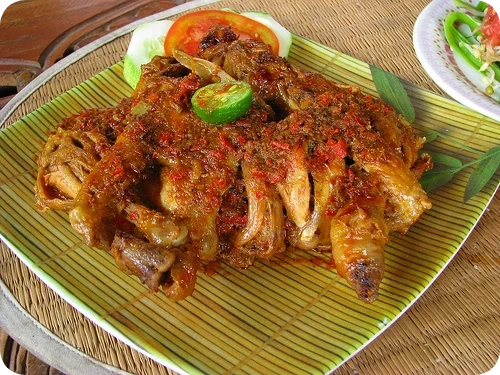
Bebek and Ayam Betutu are traditional Balinese dishes known for their deep, aromatic flavor and labor-intensive preparation. Both use either duck (bebek) or chicken (ayam), generously coated with base genep—a complex spice paste made from turmeric, garlic, shallots, candlenuts, galangal, lemongrass, chilies, and shrimp paste. This paste is sautéed in coconut oil to bring out its full aroma before being rubbed into the meat.
The marinated meat is then wrapped in banana leaves and slow-cooked for several hours. Ayam Betutu is often steamed or roasted, resulting in juicy and tender chicken that absorbs all the spices. Bebek Betutu is usually cooked over hot coals, creating a slightly crispy texture and an earthy, smoky undertone that complements the rich spice blend.
Both versions are served with steamed rice and sambal matah, a raw Balinese chili relish made with shallots, lemongrass, lime leaves, and coconut oil. The combination of tender meat, layered spices, and fresh sambal offers a balanced and intensely flavorful experience, making Betutu one of Bali’s most celebrated street food staples.
Transform Your Life With a Lifestyle Investment
Take control of your future by owning property in Bali. It’s not just an investment; it’s a lifestyle upgrade that balances work, leisure, and global living.
Sate Lilit
A little different from regular satay, Sate Lilit brings a distinctly Balinese twist. Instead of marinated meat chunks, it uses minced meat—often fish, chicken, pork, or duck—blended with grated coconut, coconut milk, lime juice, shallots, turmeric, chilies, and other local spices.
The flavorful mixture is then wrapped around flat bamboo sticks or aromatic lemongrass stalks and grilled over charcoal until lightly charred. This gives each bite a smoky, juicy taste with hints of citrus and spice.
And unlike the usual satay served with peanut sauce, Sate Lilit is typically enjoyed on its own or with sambal matah, allowing the bold flavors to shine through.
Sate Ayam
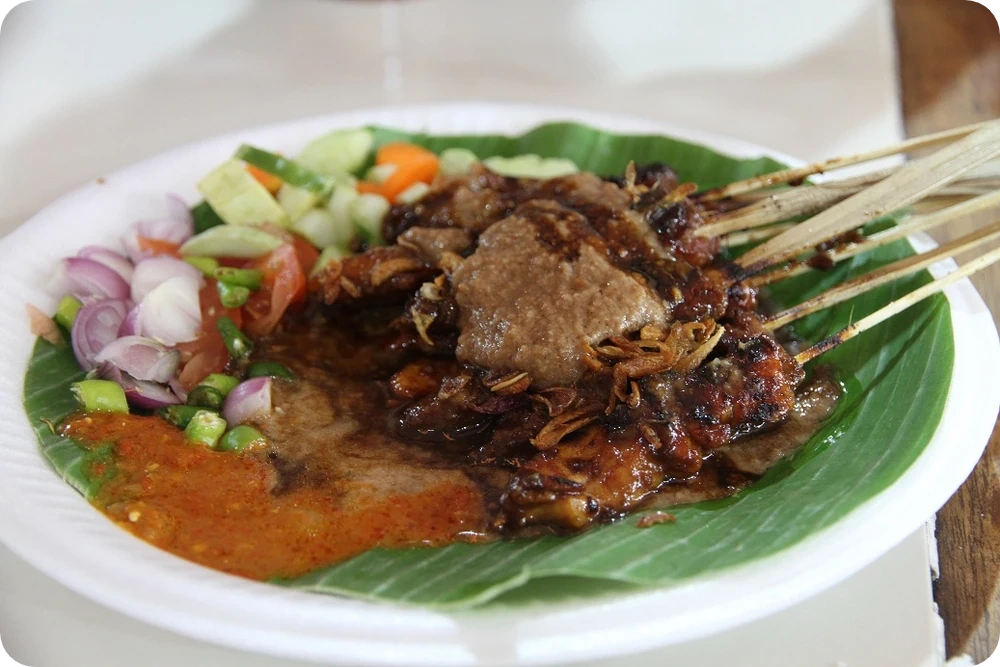
Sate Ayam is one of Indonesia’s most popular street foods, made with skewered, marinated chicken grilled over charcoal until juicy and slightly charred. Its savory-sweet flavor comes from a marinade of garlic, coriander, sweet soy sauce (kecap manis), and other local spices.
Traditionally served with a creamy peanut sauce made from roasted peanuts, garlic, tamarind, and chili, it’s often paired with lontong or compressed rice cakes. In Bali, some variations even use spice blends found in dishes like babi guling or betutu, adding notes of cinnamon, nutmeg, tamarind, cardamom, and even shrimp paste for a bolder twist.
Bakso
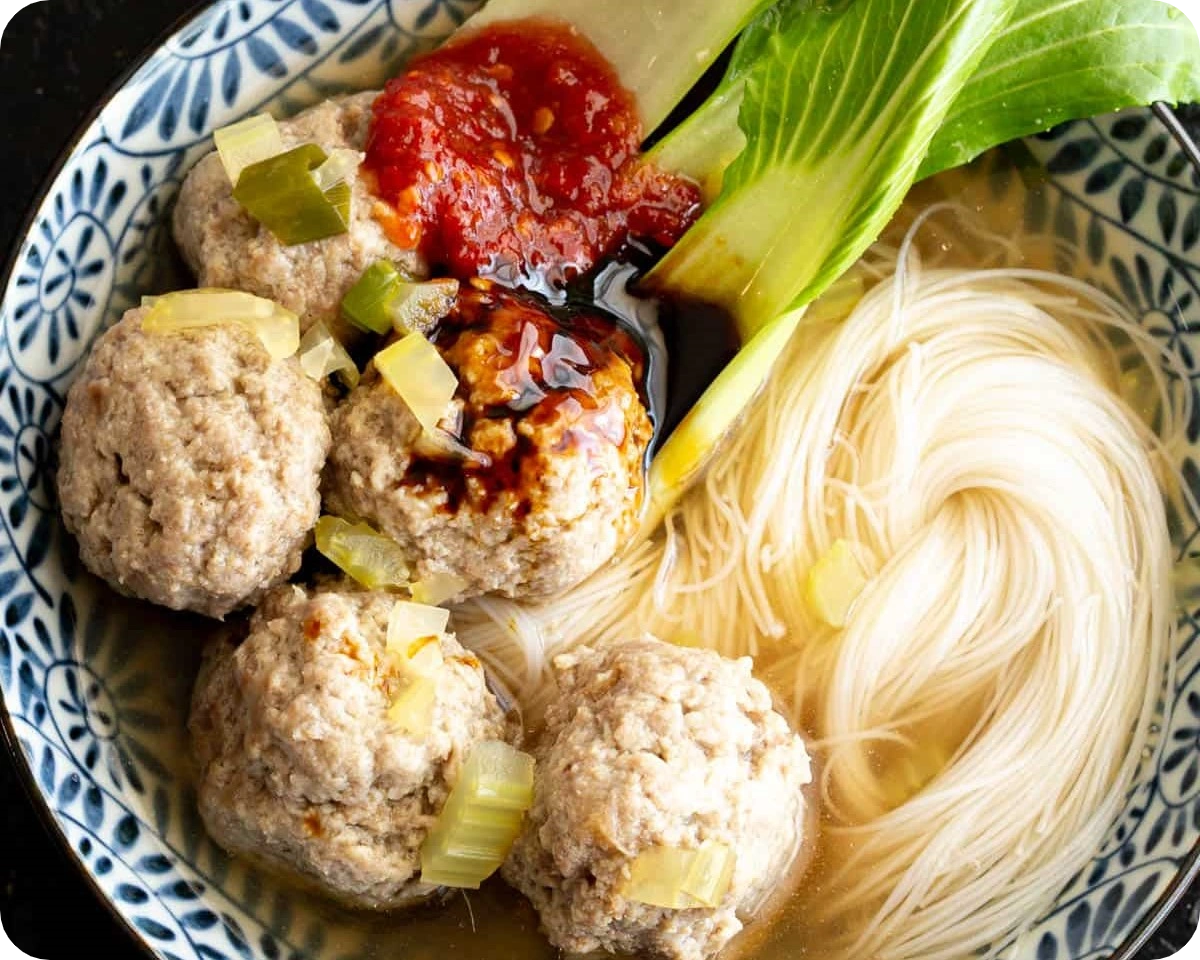
Bakso is a flavorful Indonesian meatball soup known for its springy beef or chicken meatballs served in a clear, savory broth. The chewy texture comes from a blend of finely ground meat and tapioca flour, and the soup is often topped with noodles, tofu, fried wontons, sambal, and sweet soy sauce (kecap manis) for a sweet and spicy kick.
Beyond the soup, bakso meatballs are incredibly versatile. You can toss them into nasi gila (crazy rice), stir them into pasta sauce, or simply coat them in kecap manis for a quick snack known as bakso kecap.
And while traditionally meat-based, Bali offers plant-based bakso using tofu or mushroom “meatballs.”
Fish Head Soup
Fish head soup, or sup kepala ikan, is a cherished Indonesian dish known for its rich, aromatic broth and tender fish head meat. The soup typically features a blend of spices like turmeric, galangal, lemongrass, and tamarind, creating a savory and slightly tangy flavor profile. In Bali, the broth is often enhanced with bumbu gede, a traditional spice mix, and finished with a squeeze of Balinese lime for a refreshing kick.
Nasi Campur and Nasi Ayam
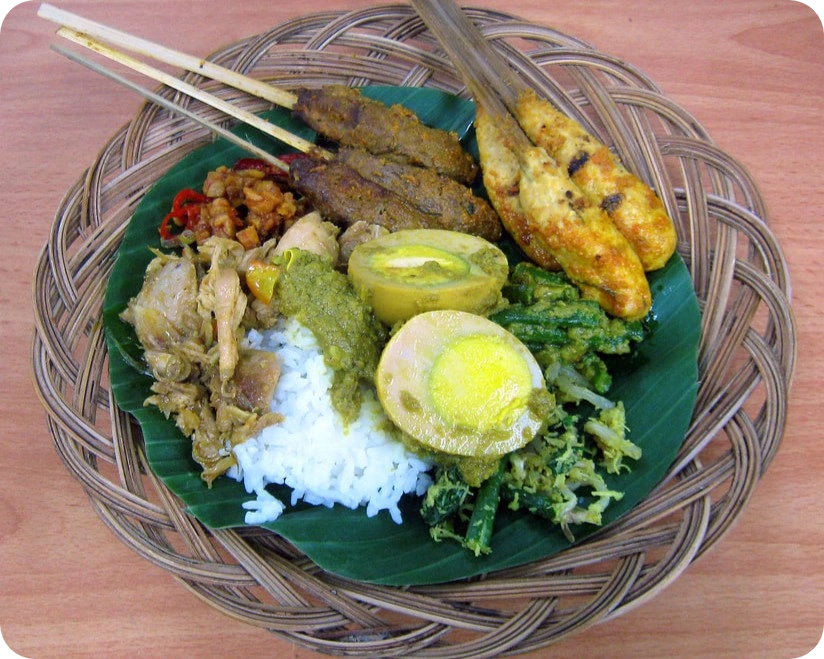
Rice is a staple of Indonesian cuisine, and in Bali, it is more than just a side dish. It serves as the heart of two beloved meals: Nasi Campur and Nasi Ayam.
Nasi Campur is a mixed rice dish served with small portions of vegetables, meats (can be pork or beef), sambal matah, egg, peanuts, and fried-shrimp krupuk. Nasi Ayam or chicken rice, on the other hand, typically features yellow rice infused with turmeric and paired with grilled or shredded chicken seasoned with garlic, cumin, and ginger. Both offer a flavorful snapshot of Bali’s rich culinary traditions.
Nasi Goreng & Mie Goreng
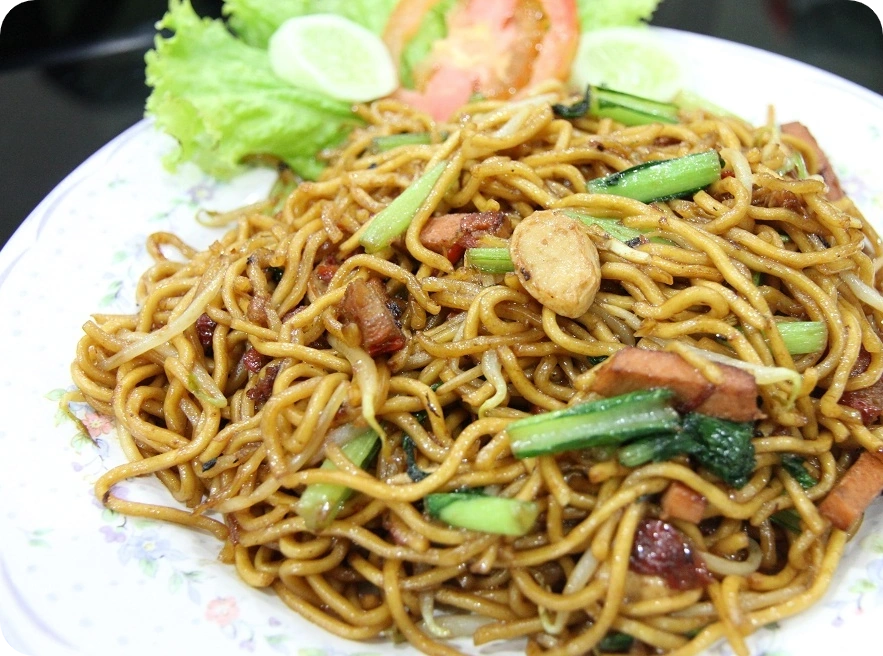
A staple in Indonesian cuisine, Nasi Goreng is a fragrant, flavorful fried rice dish made with pre-steamed rice stir-fried in sweet soy sauce, chili paste, and aromatic spices. It often includes shredded chicken, shrimp, or beef, along with vegetables like carrots and green peas, and is topped with fried shallots and krupuk for extra crunch.
Mie Goreng is its noodle counterpart—chewy egg noodles stir-fried with a similar blend of spices, vegetables, and proteins. For vegans and health-conscious food lovers, both dishes can be made vegetarian by swapping in tofu or tempeh, making them popular, satisfying options at any time of the day.
Martabak Telor

Martabak Telor is a beloved Indonesian street food made of thin, crispy dough filled with seasoned minced meat, eggs, and chopped spring onions. The savory pancake is pan-fried until golden and usually served with a tangy dipping sauce.
Often enjoyed as a snack or light meal, Martabak Telor blends rich flavors and satisfying textures, making it a popular choice from breakfast to dinner across Indonesia.
Lawar
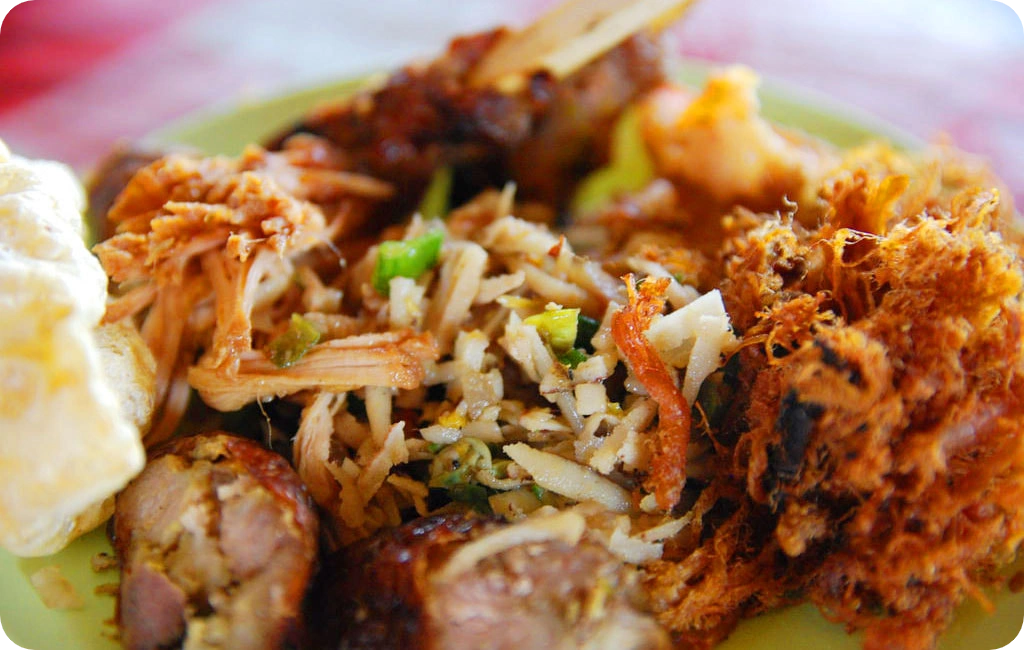
Lawar is a bold and flavorful Balinese dish made from a mix of minced meat, grated coconut, vegetables, and rich spices. What makes it truly unique is the traditional addition of fresh blood, which is believed to enhance the flavor and authenticity of the dish.
Often served as a side to Babi Guling or enjoyed on its own, Lawar comes in several variations, including pork, chicken, and even fish. Its strong, spicy profile might be intense for some, but it’s a must-try for adventurous eaters exploring Bali’s traditional cuisine.
why investors choose
coco development group?

Passive income on full auto pilot
Profit Maximization
We do not just put your property on Airbnb hoping for a guest to book it. More than 40% of our bookings comes today through our own medias, a strong community and a digital and data driven management approach.
A Convenient and fast payment system
The investors receive net profits currency that is convenient for them. we transfer the money once every three months
No need to handle taxes
High Liquidity
Fast Payback
Oceanside villas in Bali are in High demand for daily rentals. You will earn about 5000 USD per month
Vegan & Vegetarian Delights
Gado-Gado
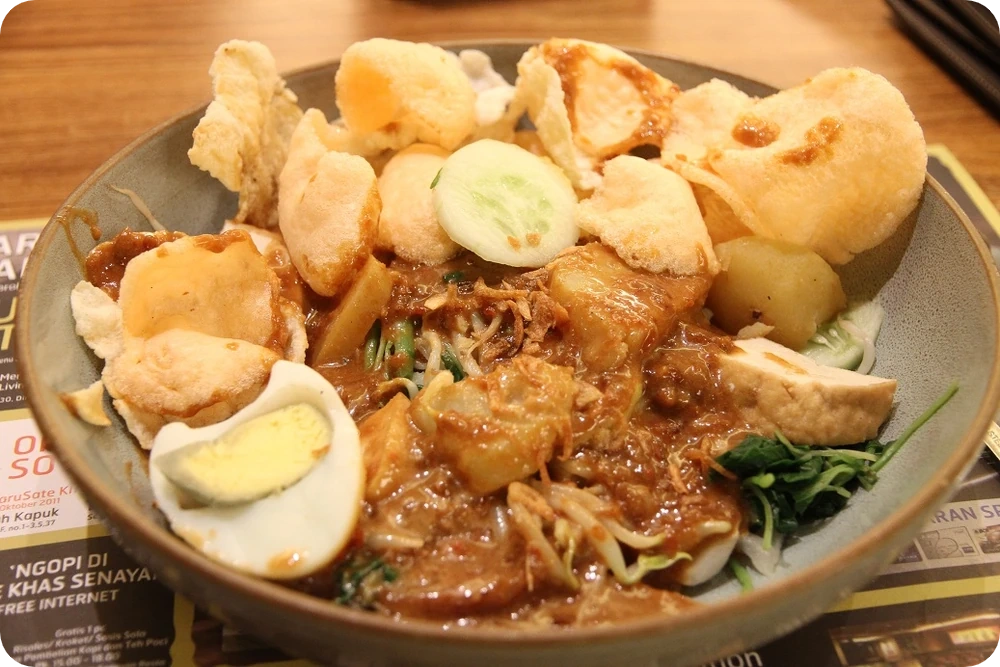
Gado-Gado is one of Indonesia’s most iconic and nourishing dishes, featuring a warm salad of boiled vegetables, tofu, tempeh (soybean cake), and optional hard-boiled eggs, all generously coated in a rich, creamy peanut sauce. Often considered a vibrant plate of textures and flavors, it is both hearty and satisfying.
For a fully vegan version, simply ask to omit the eggs and shrimp paste. This flavorful dish stands out as a wholesome, plant-based option that reflects the richness of Indonesian culinary tradition.
Tempeh Goreng
Tempeh Goreng is a beloved Indonesian dish made from fermented soybeans that are marinated in garlic, coriander, and salt before being fried to a golden, crispy texture. This dish offers a nutty flavor and a satisfying crunch, making it a popular snack or side dish. Packed with protein and fiber, Tempeh Goreng is both nutritious and delicious, perfect as a side dish, quick snack, or appetizer.
Sayur Urap
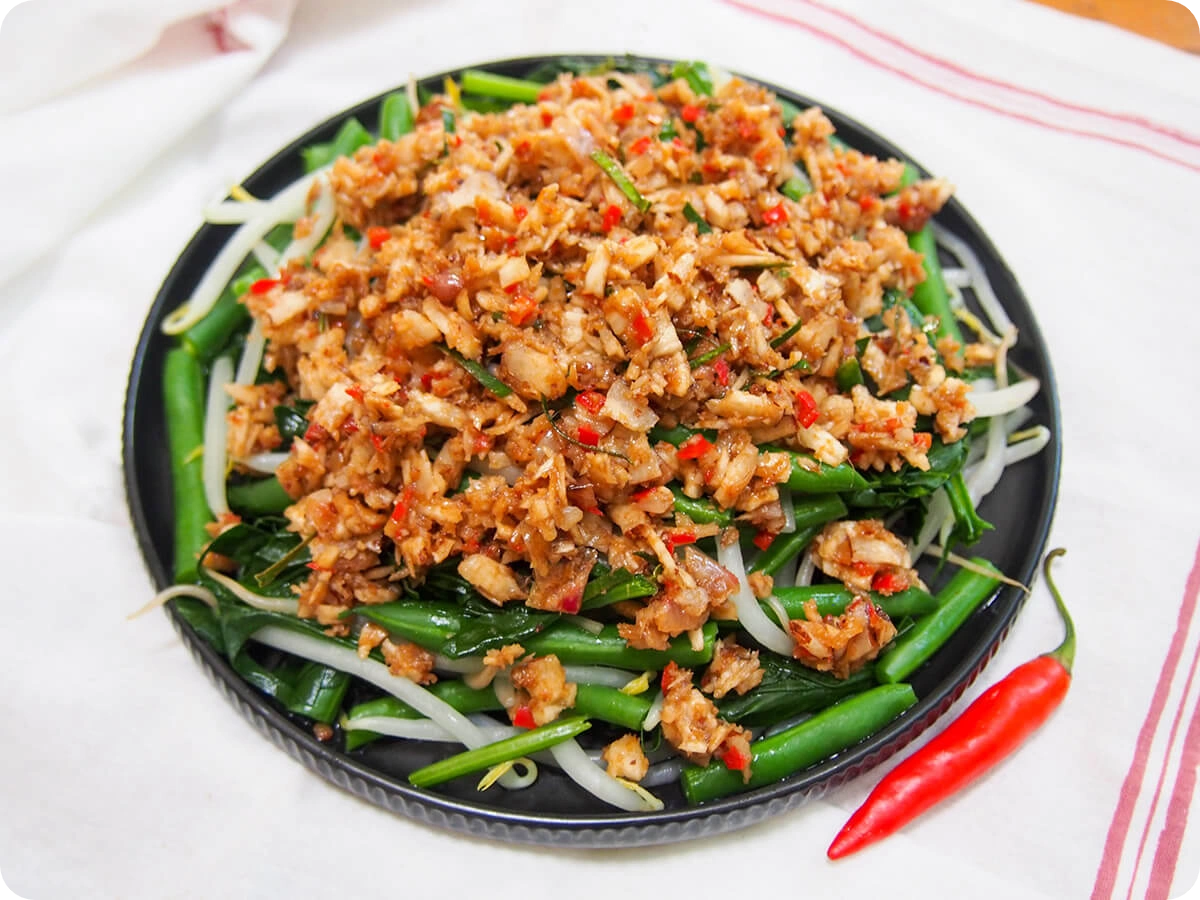
Sayur Urap is a vibrant Indonesian side dish that brings together blanched vegetables such as spinach, bean sprouts, or long beans with a spiced grated coconut topping. The addition of sambal gives it a subtle heat and tang, balancing the natural freshness of the greens. Light yet flavorful, it offers a delightful mix of textures with a signature sweet, spicy, and slightly smoky finish.
Serombotan
Serombotan is a traditional Balinese dish from the Klungkung region made with steamed vegetables like water spinach, long beans, and cabbage. These are tossed in a bold mix of spiced grated coconut, peanut sauce, and sometimes kalas—a fragrant coconut milk-based sauce infused with turmeric, garlic, and coriander.
Fully plant-based and packed with flavor, Serombotan is known for its spicy, aromatic profile and satisfying texture. It’s a vibrant and wholesome option for those looking to explore the depth of Balinese vegetarian cuisine.
Sweet, Snackable, or Customizable
Martabak Manis

Martabak Manis is a popular Indonesian street food, especially in Bali. This thick, sweet pancake is typically filled with a variety of ingredients such as chocolate sprinkles, condensed milk, cheese, and crushed peanuts, offering a rich and indulgent flavor profile. It’s commonly enjoyed as a dessert or snack, particularly in the evenings.
Pisang Goreng and Pisang Rai

Pisang Goreng and Pisang Rai are beloved banana-based snacks in Bali.
Pisang Goreng consists of ripe bananas coated in batter and deep-fried until golden, often served with a drizzle of honey or chocolate sauce.
Pisang Rai, on the other hand, features bananas wrapped in a mixture of rice flour and pandan leaves, steamed, and then rolled in grated coconut, offering a chewy texture and subtle sweetness.
Perkedel Jagung
Perkedel Jagung, or Indonesian corn fritters, are a popular vegetarian dish made from a mixture of sweet corn kernels, flour, eggs, shallots, and aromatic spices. These golden fritters are fried until crisp on the outside while remaining soft and slightly chewy inside, offering a delightful contrast in texture.
Often served as a side dish or snack, Perkedel Jagung pairs especially well with sambal, enhancing its savory sweetness with a spicy kick.
Es Campur

Es Campur is a refreshing Indonesian dessert that combines shaved ice with a variety of ingredients such as coconut, grass jelly, tapioca pearls, and assorted fruits, all drizzled with sweet syrup and condensed milk. This colorful and texturally diverse treat is especially popular during hot weather.
Jaje Bali
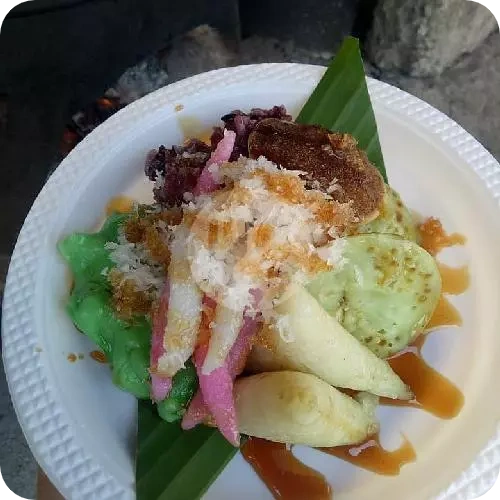
Jaje Bali refers to a wide assortment of traditional Balinese sweets typically made from glutinous rice, grated coconut, and palm sugar. These colorful and flavorful treats are often steamed or wrapped in banana leaves, reflecting the island’s time-honored culinary practices.
You can find Jaje Bali in local markets and temple offerings, where they serve not only as tasty snacks but also as meaningful representations of Balinese cultural and spiritual traditions.
Bubur Injin
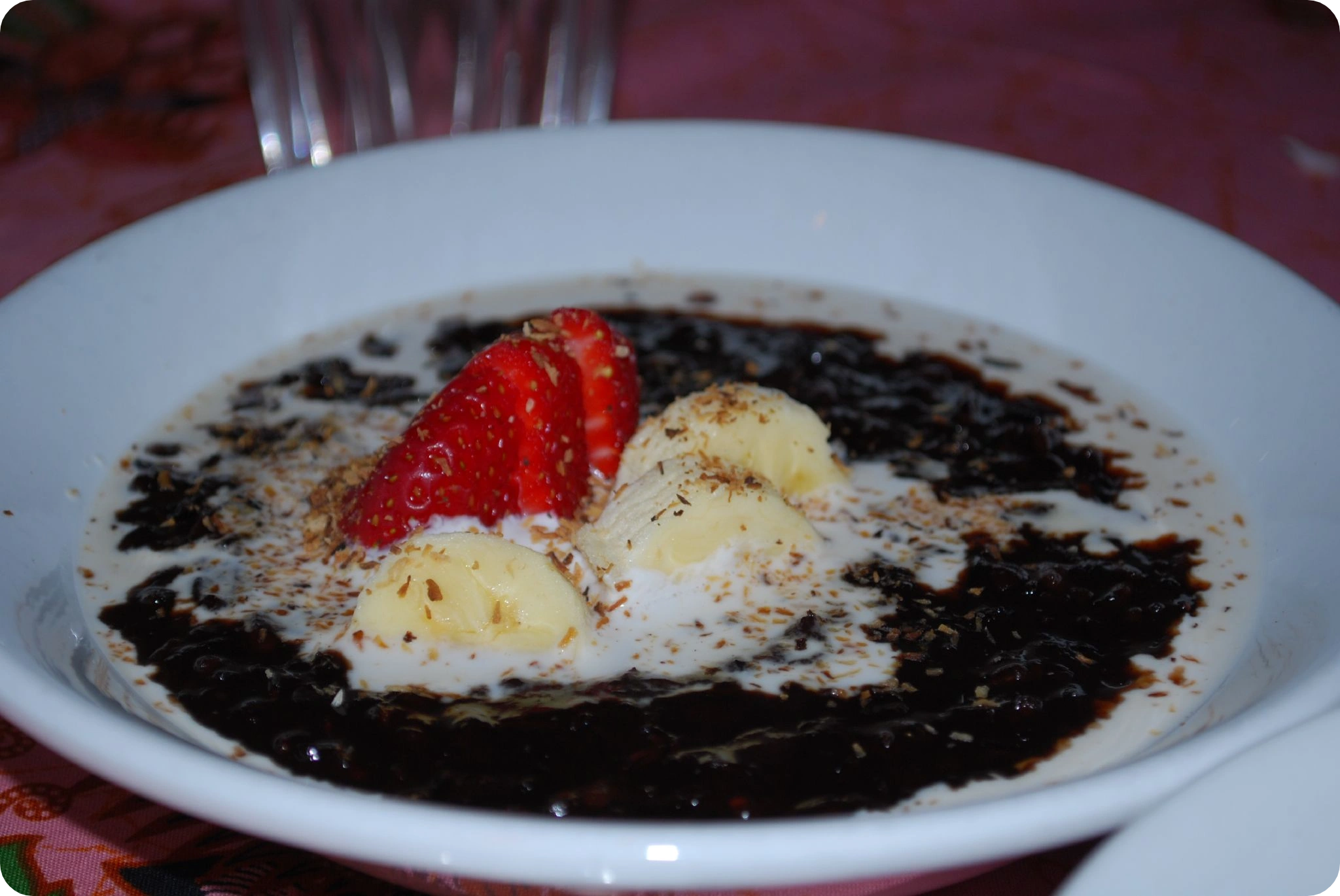
Another sweet snack made from glutinous rice—but this time using black rice—is Bubur Injin, a traditional Balinese dessert with deep cultural roots. This rich pudding is made by simmering black sticky rice until tender, sweetening it with palm sugar, and topping it with creamy coconut milk. Served either warm or chilled, its earthy flavor, satisfying chew, and velvety finish make it a beloved treat across the island.
Maximize Your ROI With Data-Driven Management
Benefit from our advanced marketing channels, strong community presence, and direct bookings that outperform standard Airbnb listings.
Drink to Pair With
Es Teh Manis
A staple in Indonesian households, Es Teh Manis is sweet iced black tea, often brewed from jasmine tea leaves and served over ice. Its refreshing sweetness makes it an ideal companion to spicy and savory dishes, balancing bold flavors with its cooling effect.
Es Jeruk
Es Jeruk is a popular Indonesian beverage made from freshly squeezed orange juice, water, and sugar, served chilled over ice. Its tangy and sweet profile provides a refreshing contrast to rich and spicy foods, making it a favored choice in local eateries.
Bali Coffee (Kopi Bali)
Grown in Bali’s fertile volcanic soils, Balinese coffee is known for its earthy, nutty flavors with hints of chocolate and low acidity. Typically served black or with sweetened condensed milk, it’s a robust brew that pairs well with traditional Balinese snacks and desserts.
Arak
Arak is a traditional Balinese spirit distilled from fermented coconut palm sap or glutinous rice. Once used in religious ceremonies, it is now enjoyed in various cocktails like the Arak Attack, offering a potent and distinctive flavor that reflects Bali’s rich cultural heritage.
Bintang Beer
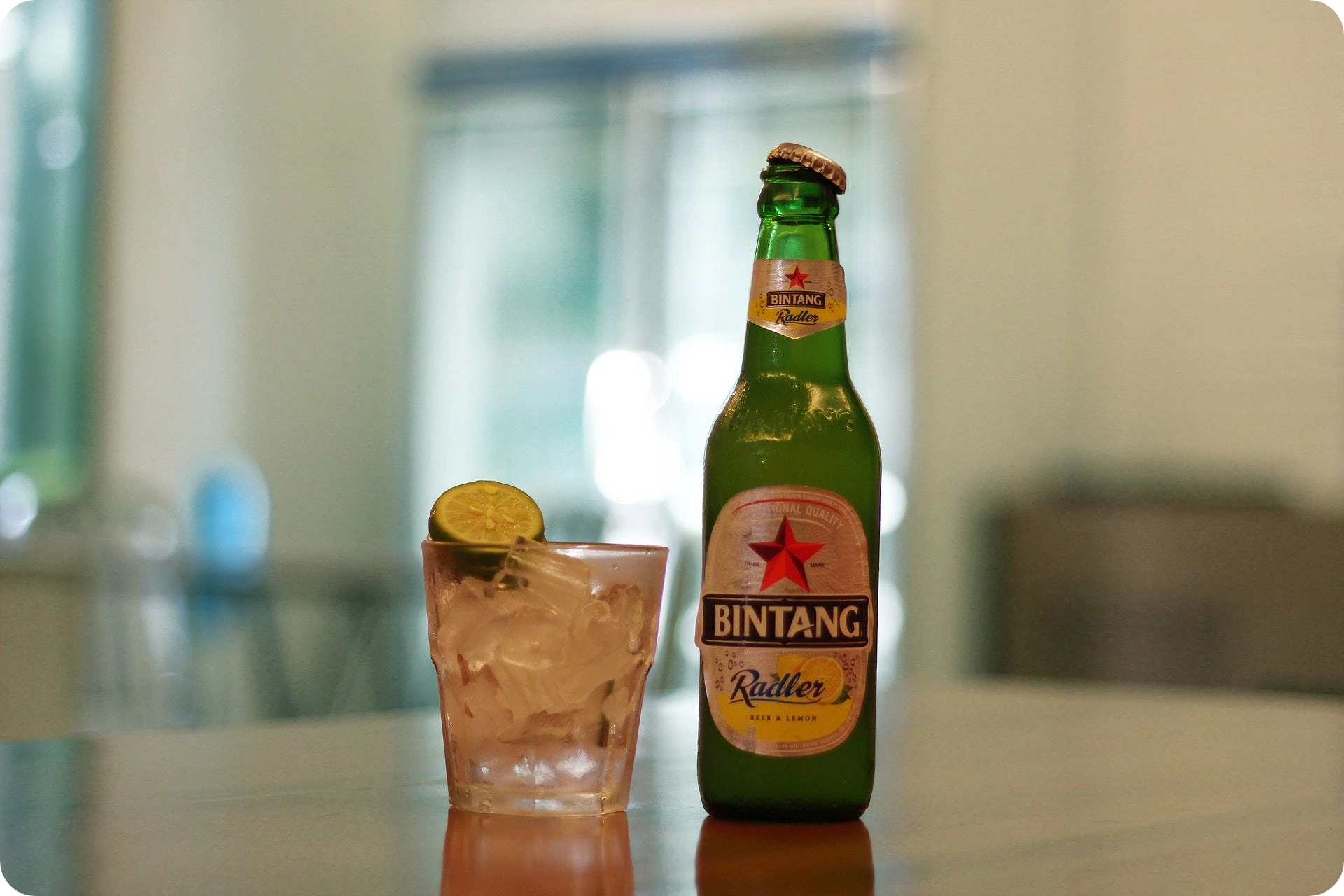
Bintang is Indonesia’s most popular beer, a light and crisp lager with a 4.7% alcohol content. Its clean taste and slight bitterness make it a refreshing accompaniment to grilled meats and spicy Indonesian dishes, widely available across Bali’s warungs, bars, and restaurants.
Bali Food Festivals to Watch Out For
Time your visit right and you could feast your way through Bali’s best food festivals:
- Ubud Food Festival (April) – A multi-day event that celebrates Indonesian cuisine with cooking demos, food stalls, and cultural talks.
- Bali Vegan Festival (October) – Held in Ubud and Canggu, this is a plant-based paradise with healthy food stalls and workshops.
- Sanur Village Festival (August) – Not strictly a food fest, but the culinary section is always packed with street eats and local favorites.
- Denpasar Festival (December) – An urban street party with live music and rows of street food vendors showcasing Balinese and Indonesian cuisine.
Construction you can trust
We handle all the details – no hassle for you.

5 Years full warranty

20+ Finished developments in Bali by our team

25+ Years of shared experience
Where to Go: Best Street Food Spots in Bali
You can find tasty food all across the island, but here are the standout spots you don’t want to miss:
- Kuta Night Market – A popular pick for tourists. It’s busy, lively, and offers everything from satay to sweets.
- Ubud Traditional Market – If you’re into plant-based food or looking for handmade sweets, this is your place.
- Sanur Night Market – Laid-back, family-friendly, and great for seafood.
- Gianyar Night Market – More local, less touristy, and known for its Babi Guling.
- Jembrana Night Market – Off-the-beaten-path with super cheap eats.
- Seminyak Night Market – More upscale with trendy stalls offering both local and fusion flavors.
- Canggu (Jalan Batu Bolong) – Healthy bowls, warungs, and street carts all along the strip—perfect for vegetarians and surfers alike.
- Badung Market
Pro Tips for Enjoying Traditional Balinese Food
Bali’s traditional cuisine is deeply rooted in culture, ceremony, and community. To fully appreciate its flavors while showing respect for local customs, here are some tips worth keeping in mind:
Join a Communal Meal
Balinese dining is often shared, with dishes placed in the center of the table for everyone to enjoy. When offered the chance to join a communal feast—whether in a family home, a village gathering, or a temple celebration—accept with gratitude. It’s one of the best ways to experience authentic Balinese hospitality.
Respect the Rituals
Food is not only for eating but also for offerings. Some dishes, like babi guling or lawar, may first be presented at temples before being served. Be mindful not to touch or eat from offerings until they are officially completed, and observe how locals handle ceremonial food.
Eat Where the Locals Eat
Follow the crowd—locals know where the best food is. High-traffic warungs and food carts usually mean better food and faster turnover, which also lowers the risk of eating something that’s been sitting too long.
Learn the Lingo
A few local terms can go a long way:
- Pedas = Spicy
- Tidak pedas = Not spicy
- Tanpa daging = Without meat
- Terima kasih = Thank you
This not only helps with ordering but also shows cultural appreciation.
Eat Where the Locals Eat
While street food thrives in night markets, warungs (family-run eateries) are the best places to savor traditional dishes in an authentic setting. They often serve recipes passed down through generations, prepared with care and devotion.
Mind Dining Etiquette
Balinese culture values respect and modesty at the table. Use your right hand when eating without utensils, avoid wasting food, and wait for elders or hosts to begin before you start eating. A little cultural respect goes a long way.
Try Regional and Ceremonial Specialties
Don’t miss dishes that define traditional Balinese cooking, such as bebek betutu (slow-cooked duck with spices), lawar (vegetable and meat mix), and sate lilit (minced meat satay). Many of these dishes have ceremonial origins, so tasting them offers insight into Bali’s cultural identity.
Try Combo Plates and Local Specials
Opt for diverse, budget-friendly meals like Nasi Campur, where you get a little bit of everything—from meats and veggies to sambals and fried noodles. Don’t just stick to the familiar; taste dishes unique to Bali like Babi Guling, Lawar, or Serombotan.
Balance Spice and Hydration
Balinese food is rich and often spicy, so pace yourself and pair meals with plenty of water or refreshing local drinks like es daluman (a herbal jelly iced drink). Eating slowly allows you to fully savor the depth of flavors.
Pay 25% of Your Property Straight From Rental Profit
Reduce the financial burden. Use your own villa’s rental income to pay down your investment cost for optimal cash flow and long-term returns.
FAQ
While Balinese cuisine uses many spices, not all dishes are fiery hot. Some, like lawar or sambal-based meals, can be quite spicy, but others rely more on aromatic blends than heat. Dishes are often adaptable to different spice preferences.
Rice is the heart of every Balinese meal, symbolizing life and prosperity. It is served with almost every dish and holds both nutritional and spiritual importance, often offered to the gods before being eaten.
Yes, although meat is central to many ceremonial dishes, Bali also has a wide variety of vegetarian-friendly meals featuring tofu, tempeh, vegetables, and coconut-based sauces. Sayur urap (vegetables with grated coconut) is a good example.
Traditional markets (pasar) are where locals buy fresh produce, meats, and spices daily. They’re also social hubs where community interactions happen, making them an essential part of Bali’s food culture.
Absolutely—many cooking schools and homestays in Bali offer hands-on classes where visitors can learn to make spice pastes, grill satay, or prepare ceremonial dishes, often starting with a guided market tour.
Taste the Spirit of Traditional Balinese Cuisine
Balinese cuisine is more than just food; it is a window into the island’s spirit. From richly spiced roasts and slow-cooked ceremonial dishes to delicate vegetables wrapped in banana leaves, every plate carries stories of ancestry, devotion, and community.
Dining in Bali is about more than flavor. It is about connection, whether through a family-style meal, offerings prepared for temple ceremonies, or hands-on cooking with locals using age-old techniques. Each experience reflects the island’s balance of tradition, spirituality, and hospitality.
Come hungry, open your senses, and immerse yourself in a culinary journey that lingers long after the last bite. In Bali, food is not simply eaten—it is celebrated.

Rasmus Holst is a serial entrepreneur and Co-Founder of COCO Development Group, where he helps drive innovation and growth through strategic business development. He is also the Co-Founder of Estate of Bali and Regnskabshelten.dk, Denmark’s fastest-growing accounting firm, which grew to 35 employees and generated $2.5M in turnover in 2023. Rasmus is passionate about building businesses that create long-term value and impact.













